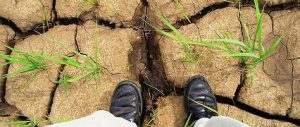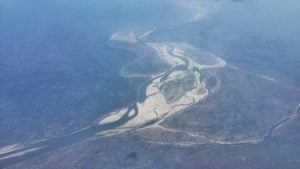This is a shorter version of an article that first appeared in Solutions journal. It is based on the papers “A safe operating space for humanity”, published in Nature, and “Planetary boundaries: Exploring the safe operating space for humanity”, published in Ecology and Society. See these papers for a complete description of the planetary boundaries.
Over the past half century, we have become adept at dealing with environmental problems on a local and global scale. The worst excesses of the industrial revolution have, in many cases, been ameliorated. Rivers, such as the Thames in London, have been cleaned up and the air quality in major cities, such as Los Angeles, is better. Synthetic pesticides once sprayed on our crops, such as DDT, have been banned in most developed countries, and lead has been removed from petroleum-based fuels.
However, to say we have done enough globally would be false on two counts. First, while these problems have been addressed in many European and North American nations, over three-quarters of the world’s people do not live in developed countries. For them, many of the local and regional environmental problems still exist and, in many cases, are worsening.
Second, the environment – our life-support system – is under increasing threat from a wide range of human pressures, many of them emanating from consumption in wealthy countries. The deterioration of the global environment puts even more pressure on the poorest countries to limit growth, even as they struggle to bring their populations out of poverty.
This is an entirely new situation for humanity. In the past, when we fouled our local environment, we could move somewhere else. As human population has grown, these short-term solutions are no longer viable. Furthermore, the impacts of our presence were not usually felt beyond our immediate surroundings. This is also no longer the case. The world population is no longer small, spread out and technologically limited.
Does our planet have boundaries regarding the amount and type of growth it can absorb? We believe it does and that certain preconditions must be set that acknowledge and respect those boundaries.
Since the industrial revolution, the human enterprise has expanded so rapidly that we are now overwhelming the capacity of the Earth system to absorb our wastes and to sustainably provide the services we require. In the period since the Second World War, the acceleration of development has become particularly dramatic. Humanity is fundamentally changing the Earth’s physical climate, overwhelming its capacity to provide ecosystem services, homogenising its biological diversity, and substantially modifying the global cycles of key elements like nitrogen, carbon and phosphorus.
So what is the solution to this dilemma? Humanity needs to change course, but in what direction? And what principles should guide the journey?
The problem has been recognised for several decades, and many attempts have been undertaken to define or inform solutions – limits to growth, safe minimum standards, the precautionary approach and tolerable windows, for example. These provide an excellent knowledge base from which to work toward a more sustainable future.
The concept of planetary boundaries, while building on earlier efforts, takes a rather different approach. It does not focus so directly on the human enterprise as most of these earlier approaches, but rather emphasises the Earth as a complex system. Here we identify nine areas that are most in need of set planetary boundaries: climate change; biodiversity loss; excess nitrogen and phosphorus production, which pollutes our soils and waters; stratospheric ozone depletion; ocean acidification; global consumption of freshwater; change in land use for agriculture; air pollution; and chemical pollution (table 1).
By “boundary”, we mean a specific point related to a global-scale environmental process beyond which humanity should not go. The position of the boundary is a normative judgment, informed by science but largely based on human perceptions of risk.
This doesn’t mean that any change in the Earth system is dangerous. Our planet can undergo abrupt changes naturally. An example is the sudden switch in North Atlantic ocean circulation when a critical level of freshwater input is reached. But these thresholds and abrupt changes are intrinsic features of the Earth system and cannot be eliminated or modified by human actions, such as the development of new technologies. We have to learn to live with thresholds and respect them.
An abrupt change is a hardwired feature of the Earth system independent of human existence, while violation of a boundary is a subjective judgment by humanity about how close we wish to approach dangerous or potentially catastrophic thresholds in our own life-support system.
Climate change, biodiversity loss, and phosphorus and nitrogen production are just three areas in which boundaries can be determined and measured, and we will use these as examples.
Human-provoked climate change is no longer disputed. Scientists can describe climate change by studying the consequences of increasing levels of carbon dioxide in our atmosphere. Our proposed climate boundary is that human changes to atmospheric carbon dioxide should not drive its concentration beyond 350 parts per million by volume, and that radiative forcing – the change in the energy balance at the Earth’s surface – should not exceed 1 watt per square metre above preindustrial levels. Transgressing these boundaries could lead to the melting of ice sheets, rising sea level, abrupt shifts in forest and agricultural land, and increasing intensity and frequency of extreme events like floods, wildfires and heat waves.
A second example is biodiversity loss, which does occur naturally and would continue to some degree without human interference. However, the rate of animal extinction has skyrocketed in the post-industrial age. Compared with fossil records, today the rate of extinction per species is 100 to 1,000 times more than what could be considered natural.
Human activities are to blame: urban and agricultural development, sprawl, increases in wildfires that destroy habitat, introduction of new species into environments and the exploitation of land for human consumption – such as the destruction of the rainforests. There are estimates that another 30% of wildlife will come under the threat of extinction this century if change is not made. The dangers of biodiversity loss go beyond nostalgia for certain animals: entire ecosystems rely on certain threatened species.
Setting a planetary boundary for biodiversity is difficult because there is so little known about the way in which species are interwoven and how they connect to the broader environment. However, we propose beginning by using the extinction rate as a flawed but acceptable indicator. Our suggested planetary boundary is that of 10 times the background rate of extinction. More research will likely change this boundary.
In our third example, we propose that no more than 11 million tonnes of phosphorous should be allowed to flow into the ocean each year – which is 10 times the natural background state. Excessive production of phosphorus, along with nitrogen, is a byproduct of our agricultural system. Excessive phosphorous and nitrogen production pollutes waterways and coastal areas and adds harmful gases to the atmosphere. Current levels already exceed critical thresholds for many estuaries and freshwater sites, and so further research may reduce the current phosphorus and nitrogen boundaries.
We propose that a boundary be set for each of the nine areas and it be respected globally, in order for humans to continue along a healthy, productive path for an indefinite amount of time (table 2). It is important to acknowledge that we don’t know precisely where the threshold might lie along the control variable or how much change in a slow process will undermine resilience at larger scales. Thus, we need to define a zone within which we are reasonably sure the threshold lies or beyond which we are reasonably sure that a significant degree of resilience will be lost.
Staying within the “planetary playing field” does not assure that humanity will thrive, or even survive, but straying outside the playing field will make it very difficult for humanity to thrive under any circumstances.
Global to local
Planetary boundaries are explicitly designed for the global scale and are aimed at keeping the Earth within safe ranges that existed prior to the industrial revolution. Although some Earth-system processes, such as ocean acidification, are intrinsically global in scale, others become global only when they aggregate from much smaller scales.
In no way does this mean that local or regional environmental issues have become less important. Efforts to reduce pollution and limit and reverse ecosystem degradation at local and regional scales continue to be very important and in fact have become even more important because of their larger-scale implications. However, we must now also focus on the global scale explicitly – in addition to and not at the expense of the many environmental issues we still need to solve at smaller scales. A global solution to the sustainability challenge is thus a prerequisite for living sustainably at local and regional scales.
There is much interaction among the planet’s features that lies at the heart of the planetary boundaries approach. This is not at all surprising given that the Earth behaves as a single, complex system at the global scale, but it does complicate the formulation and implementation of planetary boundaries. There are cascading impacts, in which transgressing one boundary can have implications for other boundaries. For example, converting the Amazon rainforest to a grassland or savanna could influence atmospheric circulation globally and ultimately affect water resources in East Asia through changes in rainfall.
Even small changes can have a synergistic effect when linked to other small changes. For example, conversion of forest to cropland, increased use of nitrogen and phosphorus fertilisers, and increased extraction of freshwater for irrigation could all act together to reduce biodiversity more than if each of these variables acted independently. Many changes feed back into each other.
The planetary boundaries approach doesn’t say anything explicit about resource use, affluence or human population size. These are part of the trade-offs that allow humanity to continue to pursue increased wellbeing. The boundaries simply define the regions of global environment space that, if human activities push the Earth system into that space, would lead to unacceptably deleterious consequences for humanity as a whole.
Implications for governance
As a practical solution for living sustainably in the modern era, the planetary boundaries approach raises important questions and opportunities for governance and institutions, even to the point of challenging the traditional concept of national sovereignty. We have identified four specific challenges for governance:
Early-warning systems. The nature of Earth-system dynamics strongly suggests that humanity needs a system to warn us when we are approaching potentially catastrophic points. An early-warning system is a prerequisite for being able to recognise and steer away from such thresholds.
Dealing with uncertainties. Each of the planetary boundaries is placed within a zone of uncertainty, some much larger than others. A global governance system will need to live with a certain level of uncertainty, emphasising the need for a precautionary approach when determining the position of boundaries.
Multilevel governance. Interacting with the traditional institutions that currently exist at national, subnational and local levels will be necessary, and probably complex and challenging. Creating effective multilevel governance systems will be especially important for those planetary boundaries that are based on aggregates of many local and regional actions.
Capacity to assimilate new information. Scientific research will continue to uncover more insights into the dynamics of the Earth system. This could lead to the need for additional planetary boundaries or the reformulation of existing ones. The increasing flow of new scientific information will undoubtedly put pressure on any institutional framework to keep up with the pace of new knowledge.
Ultimately, there will need to be an institution (or institutions) operating, with authority, above the level of individual countries to ensure that the planetary boundaries are respected. In effect, such an institution, acting on behalf of humanity as a whole, would be the ultimate arbiter of the myriad trade-offs that need to be managed as nations and groups of people jockey for economic and social advantage. It would, in essence, become the global referee on the planetary playing field.
While humanity is still a long way from meeting this challenge, some creative thinking about new institutions is showing some promise. For example, one proposed institution that moves in this direction is the Earth Atmospheric Trust, which would treat the atmosphere as a global common property asset managed as a trust for the benefit of current and future generations.
Earth-system science is still in its infancy and much more needs to be known to create a robust solution to humanity’s global dilemma. Nevertheless, we know enough now about the functioning of the Earth system that we must learn to respect the hardwired limits of our own life-support system. And we must find practical ways to respect those limits.
Will Steffen is executive director of the ANU Climate Change Institute at the Australian National University in Canberra.
Johan Rockström is executive director of two international research institutions, the Stockholm Resilience Centre and the Stockholm Environment Institute
Robert Costanza is professor of sustainability at Portland State University’s Institute for Sustainable Solutions.
This is a shorter version of an article that first appeared in Solutions journal.
This article is republished here as part of Nuclear Enery and Developement Programme, which is supported by the Heinrich-Boell Foundation.
Homepage image by Greenpeace


